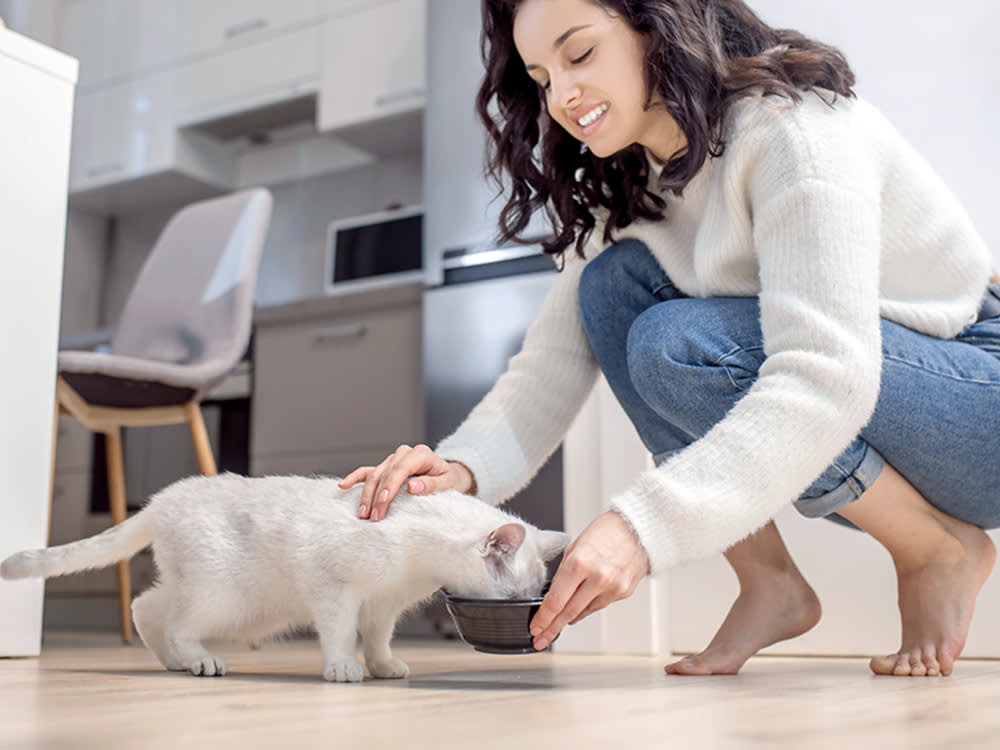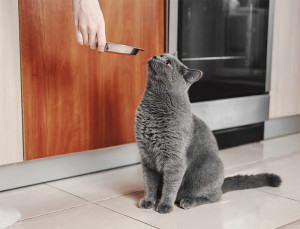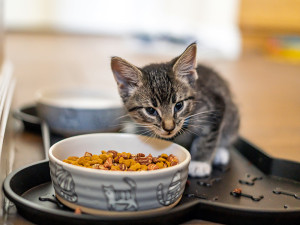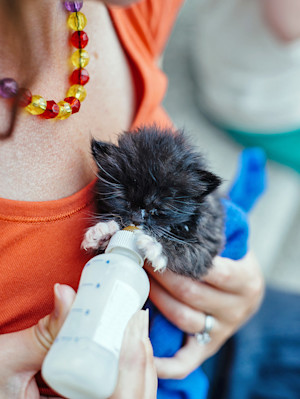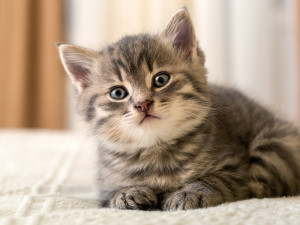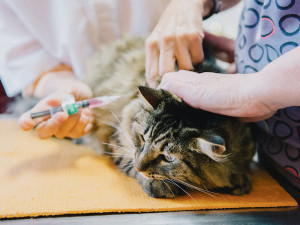What Is the Best Feeding Schedule for Cats?
Some helpful guidelines to follow.
In This Article:
How Often Should You Feed Your Cat? How Often Should You Feed Your Kitten? Factors That Affect Your Cat’s Feeding Schedule Potential Problems to Consider for Your Cat’s Feeding Schedule Frequently Asked Questions
Your kitty may be masterful at getting you to feed them all day, every day, but you know better. Sorry to be a buzzkill, cats, but a feeding schedule is the best way to measure how much and how often they should eat.
The best feeding schedule for cats is two to three meals per day, spaced eight to 12 hours apart. This mimics their natural hunting rhythm and helps maintain a healthy weight. Consistent timing and portion control are key to preventing overeating and ensuring balanced nutrition.
Save on the litter with color-changing tech that helps you better care for your cat.
How often should you feed your cat?
An ideal adult cat feeding schedule is two or three meals per day (every eight to 12 hours). Many cat parents default to feeding twice a day because it aligns well with their work schedule. Simply offering a meal before and after work keeps things consistent and easy to manage.
How much do you spend on your pet per year?
Serving meals to cats is typically preferred to free feeding. If your cat had their way, they’d probably have a bell to ring for meals on command, including 4 a.m. snacks. But feeding a cat according to their preferred schedule is often a recipe for obesity and other health issues.
How often should you feed your kitten?
Kittens need to eat more frequently than adult cats. When compared to adult cat nutrition, kittens need extra protein, calcium, phosphorus, fat, water, and certain vitamins and minerals to support their rapid growth and development.
In general, the younger a kitten is, the more often they need to eat. Nursing kittens need to eat around the clock. After weaning, kittens should still be fed frequently to allow them enough opportunity to acclimate to solid food. Before three months of age, kittens are pretty good about managing their food intake and tend to not overeat. However, kittens can start to overdo it as they pass three months of age, so they should not be free fed. As kittens get older, their daily intake can be split into larger portions until they’re being offered two or three meals a day.
How to figure out how much your kitten should eat each day
A kitten’s daily food intake depends on their age, weight, activity level, and overall health. Most commercial pet foods provide general feeding recommendations based on body weight. However, you can also calculate your kitten's needs using their age, weight, and a calculator with basic scientific functions.
This calculation helps determine a kitten’s resting energy requirement (RER) — the baseline number of calories needed to maintain a healthy, well-nourished kitten at rest. Here’s the formula for calculating RER:
RER (calories/day) = 70 ⨉ (body weight in kg)^0.75
Resting energy requirement (RER) gives us a jumping off point, but that’s not the end of the calculations. Young kittens may be healthy and well-fed, but their little bodies are doing everything but resting. They’re growing and developing, and that takes a lot of energy. So, until they approach their adult body weight, we need to multiply RER by 2.5 times to account for those extra demands.
So, for a growing kitten, the formula becomes:
RER (calories/day) = 2.5 ⨉ [70 ⨉ (body weight in kg)^0.75]
Here’s an example of the math for RER for a 1.4 kg (three-pound) kitten:
RER = 2.5 ⨉ [70 ⨉ (1.4)0.75]
RER = 2.5 ⨉ [70 ⨉ 1.28]
RER = 2.5 ⨉ 89.6
RER = 224 calories/day
Note: If you have your kitten’s weight in pounds, divide by 2.2 to convert to kilograms.
Even with that multiplier to account for kittens’ extra needs, there's still a lot of variation in nutritional requirements. Actual energy requirements can be up to 50 percent higher or lower than formulas suggest. Regularly monitoring your kitten's weight and body condition with your veterinarian is essential to ensure they're growing appropriately, and it allows for dietary adjustments as needed.
But as a rough reference, you can refer to this sample cat feeding schedule by age:
Factors that affect your cat’s feeding schedule
Pets love consistency, and creating the right feeding schedule for your cat is important for maintaining their sense of security and overall health. Several factors can affect your cat’s ideal feeding schedule, including your cat’s age, activity level, medical history, and body condition score (basically, how lean or chubby they are). So when determining, “How often should I feed my cat?” keep these considerations in mind:
Age
Kittens need to eat more often than adult cats. If young kittens go too long between meals, they are at risk of developing low blood sugar and low body temperature. Adult cats with endless access to food are at risk for becoming obese, which increases their likelihood of developing diabetes, arthritis, or other weight-related health issues.
Health
Certain health conditions require a more structured feeding schedule. Cats on certain medications need their meals timed around their doses to help manage drug absorption, efficacy, and possible side effects. For example, cats with diabetesopens in new tab must eat a meal before receiving a dose of insulin to avoid developing low blood sugar. Additionally, many oral medications can cause nausea if given on an empty stomach, so vets will recommend they receive it at dinner time.
Behavior
Some cats tend to eat too quickly and will gorge themselves to the point of vomiting. For cats with this habit, smaller, more frequent meals or using food puzzlesopens in new tab can help prevent overeating and improve digestion.
Household
If one cat in a multi-cat household requires a prescription diet, cat parents should take measures to prevent food sharing. This can mean feeding cats at separate times or in different areas, which could impact the overall feeding routine.
Environment
Outdoor feeding or feeding in areas like garages can attract pests if your cat does not finish meals in a timely manner. In these cases, timely meals and removing leftovers right away are important to prevent unwanted visitors.
Potential problems to consider for your cat’s feeding schedule
Despite cat parents’ best efforts, sometimes there are hiccups in their cat’s feeding schedule. Here are some potential problems to consider when planning your cat's feeding schedule:
Your own schedule
If you have a long commute, late work hours, frequent errands, or extra obligations, it may be difficult to maintain a consistent feeding routine. Being away from home for extended periods could make it challenging to stick to feeding every eight or twelve hours.
Food spoilage
Wet food can start to spoil if left out too long, especially in warmer environments. Once a can or packet of sealed cat food is opened, it’s exposed to oxygen and bacteria, and the clock starts ticking. Wet food should not be left out for more than a few hours. Even when dealing with a picky eater, cat parents may have to alter the feeding schedule to prevent wet food from being left out too long.
Cat grazing vs. set meal times
Having set meal times is preferred to free feeding because it makes portion control easier. It also makes changes in your cat’s food intake more noticeable. Some cats truly prefer to graze all day. This can be fine if your cat is solo, but may not be ideal if there’s another cat around wanting to hoard all the food. A cat grazing can be okay if they’re an only child, but be sure to pay attention to how often you’re refreshing the food, as changes in food intake can be easier to miss.
How to feed your cat when you’re away
Planning a vacation also means arranging care for your cat. Options include using an automated feeder or hiring a pet sitter. While an automated feeder can maintain consistency, having a human touch is better for longer absences to intervene in cases of feeder malfunctions or to spot other issues that may arise with your cat.
FAQs (People also ask):
How much should I feed my cat?
The amount of food your cat should eat depends on their age, size, health status, and the type of food being fed. A cat’s daily intake (usually found on the cat food label) should be determined and divided into multiple meals throughout the day.
How long can cats go without eating?
How long cats can go without food depends on many factors, including age and overall health. Typically, a healthy adult cat can go a day without food without major significant repercussions as long as they have access to plenty of water.
What are the best times to feed a cat?
The best times to feed your cat are those that allow you to be consistent. Many cats thrive with a meal in the morning and another in the evening. Consider your schedule and your cat’s needs when determining when to feed your cat.
References:
University of Wisconsin–Madison: Caring for Kittens from Birth to Eight Weeksopens in new tab
Assessment of Body Weight for Age Determination in Kittensopens in new tab
Today’s Veterinary Nurse: Nutrition Math 101: Important Calculationsopens in new tab
